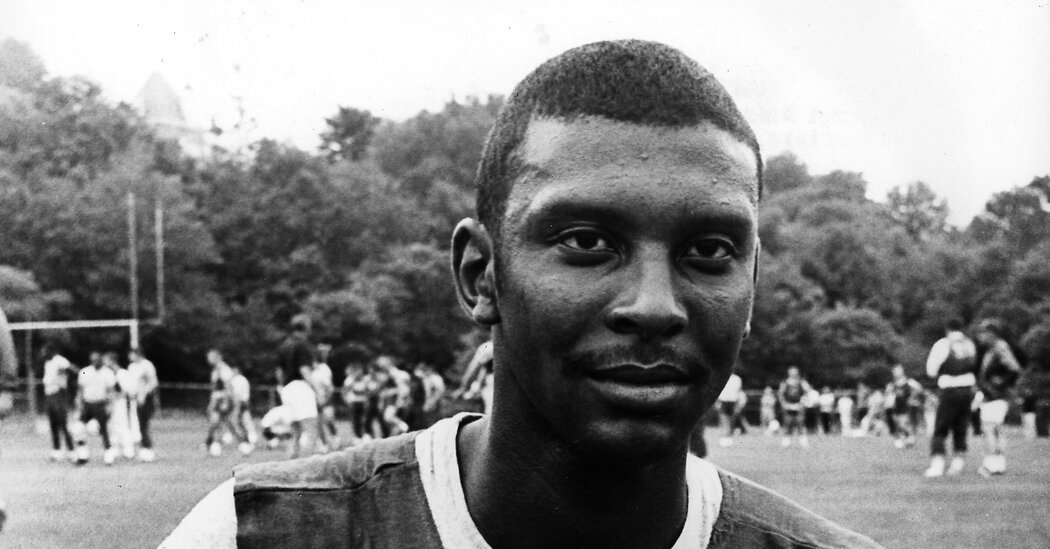Homer Jones, one of the greatest receivers the New York Giants have ever had and perhaps one of the most underappreciated in the history of pro football, died on Wednesday in Pittsburg, Texas. He was 82.
His daughter Lacarroll Jones Nickleberry said the cause of his death, at a hospital, was lung cancer.
Largely because of a troublesome knee, Jones’s career was brief: seven seasons, including his final one, mostly as a kick returner, with the Cleveland Browns. But between 1965 and 1969, playing with Giant teams that were mediocre or worse, he was among the most feared pass catchers in the National Football League.
Jones was not always sure-handed, but he was a big-play specialist, more than half of whose 36 career touchdowns went for 50 yards or more, including 10 of at least 70 yards. His 98-yard reception of a bomb from quarterback Earl Morrall in 1966 was the longest for a Giant until Victor Cruz scored on a 99-yarder in 2011.
For his career, Jones gained an average of 22.3 yards per catch, which, more than 50 years later, remains the highest in history for receivers who caught at least 200 passes.
At 6-foot-2 and 225 pounds, he was big enough to break tackles, and he was astonishingly fast.
A world-class sprinter who once ran 100 yards in 9.3 seconds, Jones was a contemporary of Bob Hayes, the Olympic champion known as “the world’s fastest human,” who played for the Dallas Cowboys. A popular debate within the league was which of the two was faster; many thought that in football pads it was the bigger and stronger Jones.
So a race between the two men was planned for the 1968 Pro Bowl, with a reported $20,000 to go to the winner. But it was called off when the Giants’ owner, Wellington Mara, fearful of injury to his prized receiver and of cheapening the occasion, paid Jones not to participate.
Hayes and Jones helped push the N.F.L. toward a major alteration of strategy as the passing game grew in importance and offenses gave primacy to big-armed quarterbacks and speed-demon pass catchers. Defenses, without cornerbacks and safeties who could run with the likes of Hayes and Jones, shifted more to zone coverage and away from man-to-man.
But on his own, Jones influenced the future of football in a manner more recognizable to the casual fan.
He had told himself that when he caught his first touchdown pass he would express his joy, in the trendy manner of the day, by hurling the football into the stands. His chance came against the Philadelphia Eagles at Yankee Stadium on Oct. 17, 1965, when he scored on an 89-yard pass play. The problem was that the league had forbidden that practice and threatened to fine any player who contravened the order.
So instead, after he crossed the goal line, Jones threw the football down hard to the turf, performing what has been widely credited as the original end-zone “spike,” a term that Jones himself coined, ushering in an era, now 68 years along, of ever more elaborate end-zone celebrations.
Homer Carroll Jones was born on Feb. 18, 1941, in Pittsburg, a small town east of Dallas, the son of a steelworker, Horse Jones, and a schoolteacher, Beulah (Aldridge) Jones. As a youth he was more interested in music than sports, playing the saxophone in the high school marching band for two years before trying out for football as a senior.
At Texas Southern University, he starred in track as well as football, playing linebacker, running back and flanker. He injured a knee in one of his final games, harming his draft prospects, but he was still drafted in 1963 by the Houston Oilers of the American Football League in the fifth round and by the Giants in the 20th round. (The A.F.L. and the N.F.L. merged before the 1970 season; the draft is now limited to seven rounds.)
Jones chose the Oilers, who cut him in training camp because of his knee; the Giants subsequently brought him to New York, arranged to have his knee surgically repaired and waited for more than a full season until Jones regained his health and strength. He appeared in three games for the Giants in late 1964; the next season he was a starting receiver, and though he caught only 29 passes, he gained an average of a remarkable 27.3 yards per catch.
The Giants went 7-7 in 1965, and Jones never played for a winning Giants team. In 1966, he scored eight touchdowns, and for the first of three straight seasons gained more than 1,000 yards as a receiver, but the Giants were a miserable 1-12-1. That winter, New York acquired the star quarterback and future Hall of Famer Fran Tarkenton in a trade with the Minnesota Vikings, and Tarkenton recognized immediately that Jones, with his size, speed, strength and enormous hands, was a unique weapon.
“He’s like a man on a motorcycle waving a butterfly net high in the air,” Tarkenton said at the time.
With Tarkenton throwing, Jones had his two best seasons in 1967 and 1968. His 13 touchdowns in 1967 led all N.F.L. receivers; he added seven more in 1968; and he made the Pro Bowl, the league’s annual all-star game, both seasons. It would be nearly 40 years before another Giant wide receiver earned a selection to the game.
Deterioration in Jones’s knee brought his Giants career to an end after the 1969 season; he was traded to the Browns for a running back, Ron Johnson, who became a Giant stalwart in the early 1970s.
After his playing career, Jones returned to Pittsburg and worked for a steel company for 20 years.
He was married three times. In addition to Ms. Nickleberry, his survivors include two other daughters, Erica Sanders and Marcie Bell; a son, Charles Dumas; a sister, Patricia Bolton; and several grandchildren.
He is also, of course, survived by the spike, which he seemed to regret. In a 2012 interview, he said that he had watched the end-zone demonstrations over the years with disapproval, and that if he had known what would result from his act, he would have thought twice.
“It caused so many things — obscene things and confusing things,” he said. “I wish I hadn’t started it.”
Alex Traub contributed reporting.
Bruce Weber retired in 2016 after 27 years at The Times. During the last eight he was an obituary writer. He is at work on a biography of the novelist E.L. Doctorow.
Source: Read Full Article

